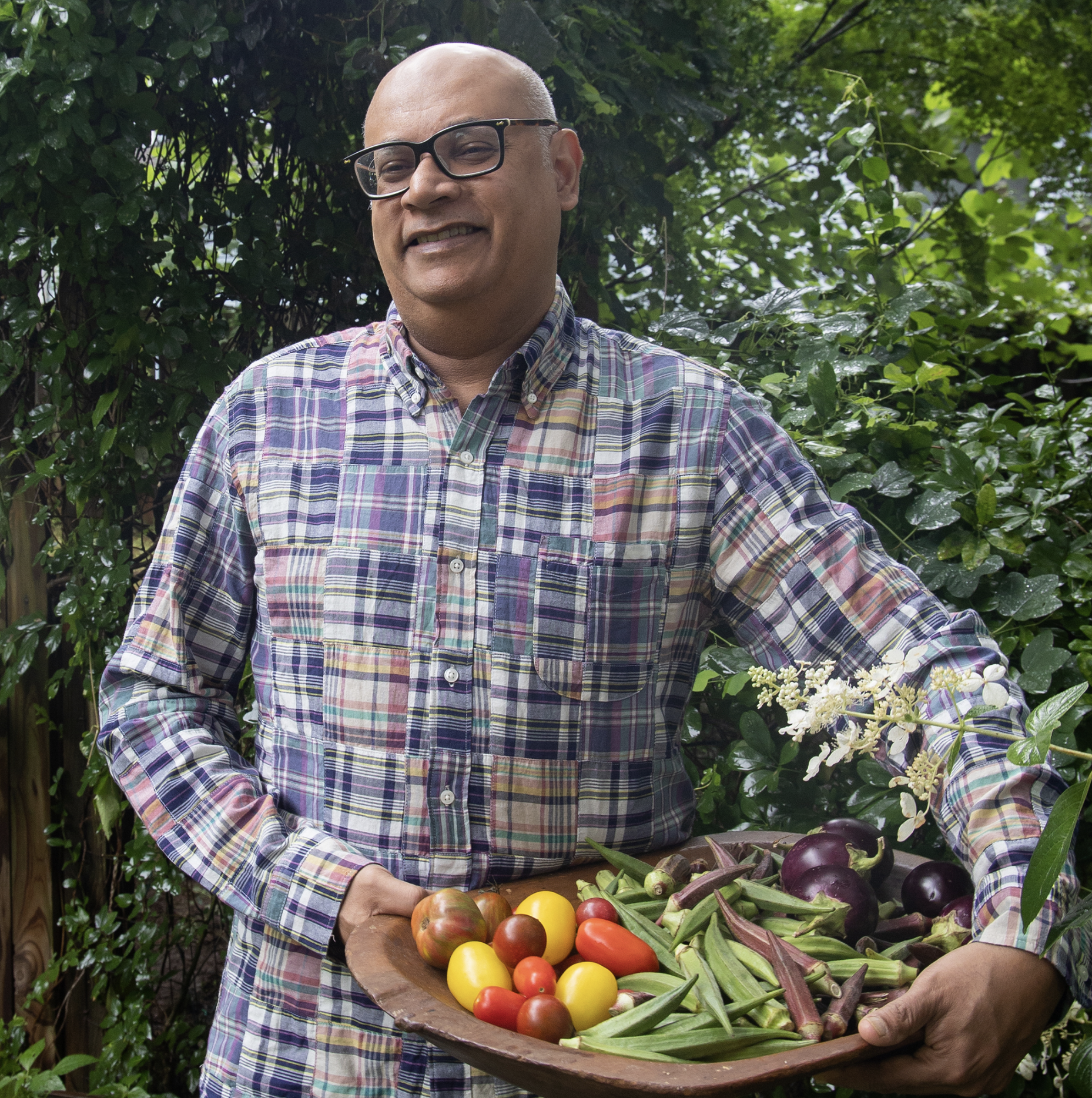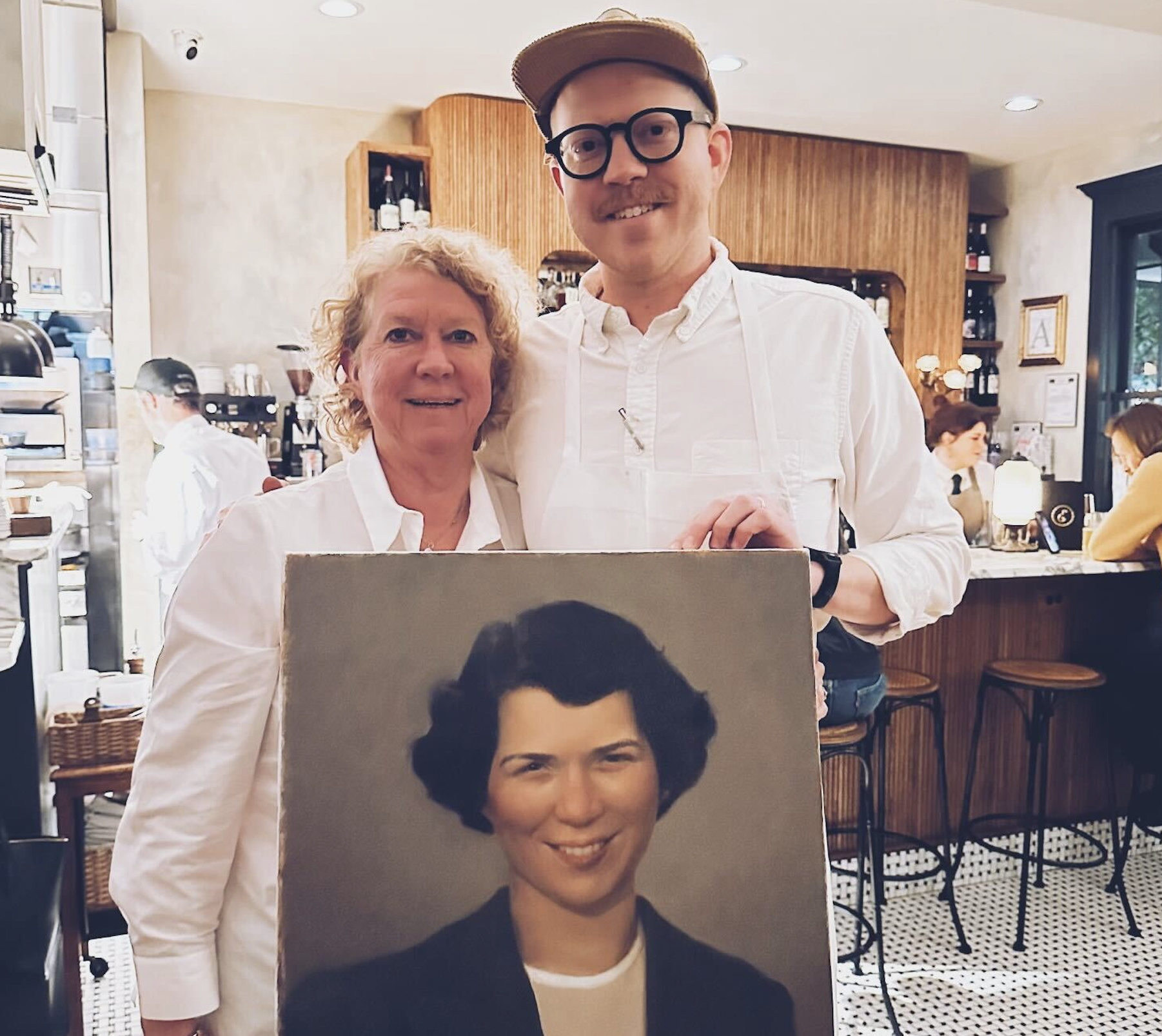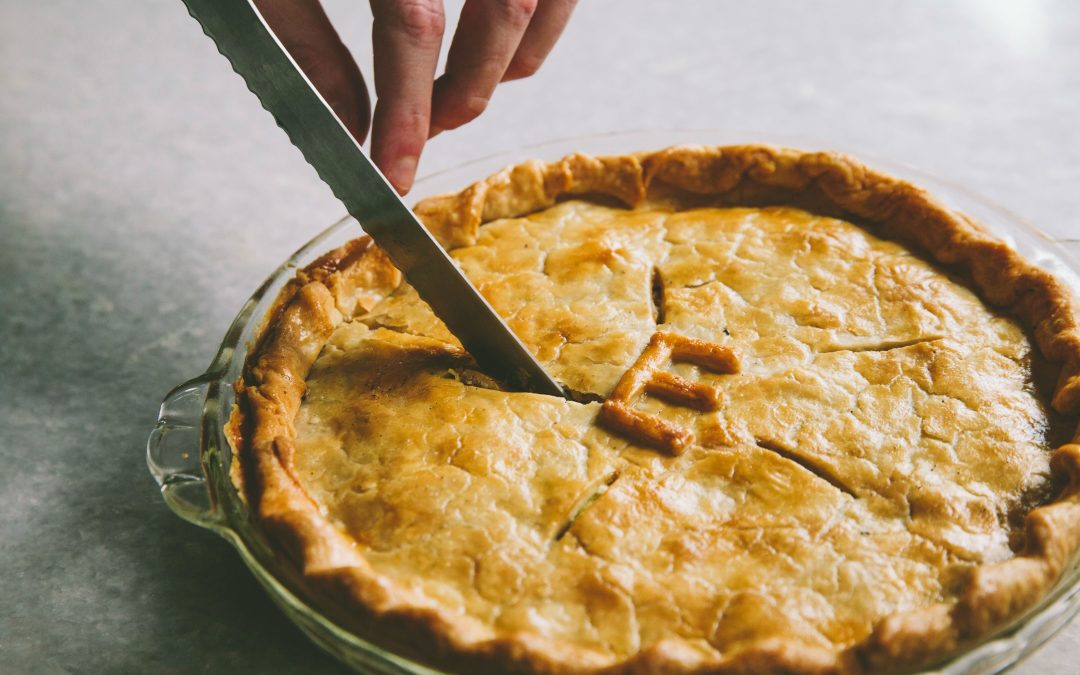Being nominated for, or even winning, a James Beard Award for culinary excellence is an achievement that most budding cooks can only dream about—maybe even as they stand on tiptoe in their childhood kitchens, helping their mothers stir a pot or prepare for dinner. But for several Mississippi chefs, James Beard accolades have become their all-grown-up reality. Their names are now mentioned alongside some of the country’s top culinary talents, and the dishes they dream up are as revered on social media as they are in their packed restaurants. It’s a long way from the stepping stool in Mom’s kitchen, but even as they cater to new audiences, these chefs haven’t forgotten the lessons their mothers lovingly handed down decades ago. On the following pages, eight Mississippi chefs who were James Beard Award semifinalists, nominees, or winners share favorite recipes from their own mothers, along with a few special memories.

From the kitchen of:
Alex Perry, Vestige, Ocean Springs
Alex Perry is no stranger to the James Beard Foundation’s attention, having been named a semifinalist for Best Chef South in 2019 and 2022, and a nominee for the same award in 2023. For 2024, Vestige—the restaurant he operates with his wife Kumi Omori, with whom he shared the 2022 and 2023 honors—has been named a semifinalist for the James Beard Award for Outstanding Restaurant. The winner will be named at a culinary star-studded ceremony in June.
“This is a soup that always cropped up around Christmas when the throng of family and friends needed to be fed on the quick,” Perry says of the recipe he selected as a favorite among those his mother prepared while he was growing up. “A pantry full of summer’s best combine with the Gulf’s riches to remind everyone of warmer weather and sandier toes. This soup always reminds me of home and holiday.”
Shrimp Soup
4 russet potatoes, cut into ½-inch cubes
1 small yellow onion, cut into medium dice
Chicken stock, as needed
1 stick unsalted butter
1 (14.5-ounce) can stewed tomatoes, chopped
½ (10-ounce) can original Rotel, blended smooth
2 tablespoons dried basil
1 pound Gulf brown shrimp, peeled
1 (7-ounce) can shoepeg corn, drained
Salt and pepper as neede
Place potatoes and onion in a large stock pot. Cover with chicken stock (add bouillon cube for extra flavor), and cook until potatoes are just tender. Drain potatoes and onions, reserving chicken stock. Set vegetables aside. Place chicken stock back into stock pot. Add butter, stewed tomatoes, Rotel, dried basil, and shrimp to stock. Bring to a simmer until shrimp are just cooked through. Add potatoes, onions, and corn to soup. Season with salt and pepper to taste.
Yield: 4 servings

From the kitchen of:
Martha Hall Foose, Loblolly Bakery, Hattiesburg
It took restaurateur Robert St. John years to entice acclaimed pastry chef and cookbook author Martha Foose and her husband, bread baker Donald Bender, to pull up their Delta roots and team up with him to open Loblolly Bakery in Midtown Hattiesburg. The bakery welcomed its first customers in August 2023, and just like she did at Bottletree Bakery in Oxford and Mockingbird Bakery in Greenwood, Foose has been satisfying sweet tooths with her signature beloved recipes plus a number of new items.
One thing that has remained on the menu at all three is Foose’s Ginger Molasses Cookies, a recipe passed down by her mother, Cindy. “My mom teaches French hand sewing,” Foose says. “She doesn’t cook, and I don’t sew. But whenever we’d have a bake sale or something at school, she’d always make those. We’re all totally molasses people.”
Foose’s cookbook Screen Doors and Sweet Tea: Recipes and Tales from a Southern Cook, in which this cookie recipe appears, won the James Beard Award for American Cooking in 2009. With Asha Gomez, Foose also co-authored My Two Souths: Blending the Flavors of India into a Southern Kitchen, which was a nominee in the same category in 2017.
Ginger Molasses Cookies
The key to getting these cookies at their chewy best is keeping a close watch on them while they are in the oven and removing them from the hot pans straightaway to a cooling rack.
2¾ cups unbleached all-purpose flour
1 teaspoon baking soda
½ teaspoon salt
1½ teaspoons ground ginger
1 teaspoon ground cinnamon
½ teaspoon ground allspice
¼ teaspoon ground cloves
¾ cup packed dark brown sugar
¾ cup (1½ sticks) unsalted butter, softened
1 large egg
¾ cup molasses
1 cup granulated sugar
Preheat oven to 350 degrees. In a medium bowl, whisk together flour, baking soda, salt, ginger, cinnamon, allspice, and cloves. In bowl of an electric mixer fitted with paddle attachment, beat brown sugar and butter at medium speed until light in color. Add egg and molasses, and beat until well combined, scraping bowl as necessary. Reduce speed to low and slowly add flour mixture. Scrape bowl and mix for 1 minute at medium speed. Form dough into tablespoon-size balls. Roll each ball in granulated sugar, and place 2 inches apart on a parchment-lined baking sheet. Bake for 10 to 12 minutes, until slightly brown and puffed. Transfer to a rack to cool. Store in an airtight container.
Note:
– Spray measuring cup with a little nonstick spray before adding molasses, and molasses will slip right out.
– A little bit of diced crystallized ginger pushed into the center of the cookies before they go into the oven dresses them up and adds a little zing.
– These cookies can be rolled in sugar, then frozen and baked a few at a time right from the freezer for an afternoon coffee break pick-me-up. Increase baking time to 15 minutes.
Yield: 24 servings

From the kitchen of:
Vishwesh Bhatt, Snackbar, Oxford
As a child in India, Vishwesh Bhatt learned to cook khichadi, a porridge-like dish made with rice and lentils, from his mother. But his father had his own preferred version, so the family alternated khichadi recipes when they served up the dish three times every week. “There are as many versions of khichadi as there are households, and if you tell anyone that yours is the definitive one, you are likely to start a fight,” Bhatt says.
Bhatt opted to share an entirely different recipe for khichadi—his grandmother’s—in his book I Am From Here: Stories and Recipes from a Southern Chef, which won the James Beard Award for U.S. Foodways in 2023. Bhatt had already been named winner of the James Beard Award for Best Chef South in 2019 after being a nominee for the award for the previous five years and a semifinalist the two years before that.
“This civil war has continued in my own household,” Bhatt writes in his book. “My wife honed her khichadi skills under my dad’s tutelage. To this day, she will put her hands on her hips, jut her chin out, and tell me what’s what if I dare suggest that she may want to ease off on the cloves.”
Khichadi
Remember that this is a dish you can personalize easily. Feel free to add and subtract ingredients as you like.
1 cup basmati rice
1 cup split pigeon peas (toor dal) or yellow lentils
½ teaspoon salt
¼ teaspoon ground turmeric
1 tablespoon ghee (store-bought or homemade), plus more for serving (optional)
½ teaspoon brown mustard seeds
6 black peppercorns
2 whole cloves
½ small cinnamon stick
½ teaspoon cumin seeds
¼ teaspoon asafoetida
Plain, full-fat yogurt (preferably Greek-style) for serving (optional)
Combine rice and pigeon peas in a large strainer. Rinse thoroughly with cold water and remove any debris. Drain and put rice-pea mixture in a heavy-bottom pot. Cover grains with 4 cups cold water. Add salt and turmeric, stir, and allow to soak for 20 minutes. Meanwhile, in a small skillet over medium heat, heat ghee until melted and fragrant. Add mustard seeds and cook until popping, about 30 seconds. Add remaining spices and swirl until toasted and fragrant, 15 to 20 seconds. Be careful of splatter. Pour ghee and spices over rice-pea mixture and bring to a boil over high heat. Once mixture starts boiling, reduce heat to low. Cover pot, leaving a very small vent for steam to escape so that liquid does not bubble over. Cook for 12 minutes, resisting urge to lift lid (steam will escape and drop temperature). When timer goes off, check for doneness; if slightly underdone or has excess liquid, cook an additional couple of minutes. When it’s done, turn off heat and allow to steam for 5 minutes. Carefully remove lid and fluff with a fork. Spoon individual servings into shallow bowls and top with a drizzle of ghee or a dollop of yogurt, if desired.
Note: Basmati is a fragrant, long-grain rice that makes a relatively “dry” khichadi. Carolina Gold would work nicely as well. If you prefer a consistency more like risotto, use a starchy, short-grain rice.
Yield: 3-4 servings

From the kitchen of:
Austin Sumrall White Pillars, Biloxi
Growing up in McComb, Austin Sumrall often cooked alongside his mother. “That side of my family is from south Louisiana, where food is the love language,” he says. “She passed that along to me: cooking for someone is how we say I love you.”
After graduating from the University of Southern Mississippi, Sumrall received classical training at the Culinary Institute of America, and he has worked under three James Beard Award winners. But after opening his own restaurant, White Pillars, Sumrall was the one to get noticed on the national stage. In 2020, he was named a semifinalist for Best Chef South by the James Beard Foundation. But he hasn’t forgotten his culinary roots in his mother’s kitchen. “She is also a fantastic cook,” Sumrall says. “I regularly run menu items by her if I feel stuck or need a new direction.”
Mom’s Chimichurri
I love the versatility and brightness of this sauce. A few tweaks and it can be used with a ton of different dishes.
1 cup mint leaves
1 cup basil leaves
1 cup parsley leaves
1 cup cilantro leaves (optional)
3 garlic cloves
1 tablespoon lemon juice
Salt and pepper to taste
1 cup (more or less) extra-virgin olive oil, divided
Combine mint, basil, parsley, cilantro (if using), garlic, lemon, salt, pepper, and ½ cup olive oil in a blender. Pulse a few times so that it is not quite smooth. More olive oil can be added for a lighter sauce.
Note: The beauty of this recipe is that it can be made chunky and full or light and smooth.
– Adding or eliminating cilantro gives it a lot of versatility and changes the flavor profile significantly.
– By playing with the amount of lemon, you can also adjust the flavor. I like to just barely be able to taste the lemon, but adding more can give it a nice, bright acidity.
Yield: 1½ cups

From the kitchen of:
Hunter Evans, Elvie’s, Jackson
Good food is a family tradition for Hunter Evans, whose childhood visits to his grandmother’s home in New Orleans—and the memorable meals he enjoyed there—so awakened his interest in cooking that he would later name his restaurant after her. In the meantime, his mother carried on the legacy of love-filled meals, often prepared with a bounty of south Louisiana and the Gulf Coast ingredients.
“A great memory I have of my mother is when we’d leave New Orleans, she would stop by a local seafood market in Hammond to load up on fresh seafood,” says Evans, who was named a semifinalist for the James Beard Award for Best Chef South in 2023 and is currently a semifinalist for the same award for 2024. “To this day she does it, and now I have started doing it.”
Crawfish Pie
The dish really takes me back to New Orleans, sharing the table with my family and our grandmother Elvie. Since opening Elvie’s, I have also started to make the crawfish pie around the holidays for people to order!
2 cups crawfish tails
Tony Chachere’s Creole seasoning
½ cup cooking oil
1 cup chopped onion
½ cup chopped celery
1½ cups chicken stock
2 tablespoons cornstarch
4 green onions, chopped
2 tablespoons chopped parsley
1 pie shell, plus additional pie crust dough
Preheat oven to 350 degrees. Season crawfish tails with Tony’s seasoning and set aside. Sauté onions and celery in oil; add crawfish tails and chicken stock and cook for 15 minutes. Add cornstarch dissolved in a little bit of water. Stir constantly until gravy is thick while stirring. Add green onions and parsley. Pour gravy into pie shell and cover with another piece of dough. Bake for 25 minutes.
Note: Shrimp may be substituted for crawfish.
Yield: 6-8 servings

From the kitchen of:
Taylor Bowen-Ricketts, Fan and Johnny’s, Greenwood
When Taylor Bowen-Ricketts was in college, she began her path into the restaurant business by working at two of the “coolest, hippest, best joints ever”—The Harvest Cafe vegetarian restaurant and the legendary Hoka in Oxford. “Those two places had more of an impact on my culinary career than anything else,” she says. “During that time I became a vegetarian for two years, being the independent, free-thinking progressive art student that I was. Two years! I can’t even imagine that now.”
But it only took a single visit back home to revert her eating preferences for good. “My mama’s chili is what broke me,” Bowen-Ricketts says. “One weekend I returned home for a visit. I foolishly chose to spend money on after-work drinks instead of food in those days, so no telling when I had eaten last besides tasting this and that in the kitchen. When I entered the house, I could smell it and knew the smell of that love and happiness waiting on the stove for me. I walked straight up to it and ate it right out of the pot.”
In 2011, Bowen-Ricketts was named a semifinalist for the James Beard Foundation’s Best Chef South award. Today, she operates a restaurant named for her grandparents in even serves her grandfather’s recipe for Comeback Sauce atop her fried alligator and fried green tomatoes.
Mama’s Chili
This recipe is a classic chili recipe, fairly simple and easy and written in the old church cookbook style. It truly is delicious and is a great example of how simplicity works every time. The secret here is love and time and patience—all characteristics of my mama. She excels in these qualities. When she says “Cook for a good long time,” that means at least half a day if not all day, tenderly stirring, tasting, seasoning and looking after the simple dish while it is transforming to something full of very complex flavor.
1 pound ground beef
1 pound sweet basil sausage
2 or more tablespoons butter
2 green peppers, diced
1 to 2 onions, diced
2 cans dark red kidney beans
1 can fire-roasted garlic tomatoes
2 or mire tablespoons chili powder or to taste
Salt and pepper to taste
Brown meat in butter. Add remaining ingredients. Cook for a good long time on stovetop or in oven. As chili comes together and cooks down, add water to maintain desired consistency.
Note: Mama always encourages adding your own personality to this recipe by adding whatever you like!
Yield: 4-6 servings

From the kitchen of:
John Currence, City Grocery, Oxford
The James Beard Foundation recognizes an authentic culinary voice when they hear it, which is why John Currence has been on their lists year after year. A nominee for Best Chef South in 2005, 2007, and 2008, he finally won the award in 2009. Then came the cookbooks: Currence’s Pickles, Pigs & Whiskey: Recipes from My Three Favorite Food Groups and Then Some was a nominee for American Cooking in 2014, and his Big Bad Breakfast: The Most Important Book of the Day was a nominee in the Single Subject category in 2017.
Currence’s culinary memories of his mother start with the impressive fact that even though she was a busy high school teacher by profession, she managed to make her two young sons a hot breakfast, pack them a lunch, and cook dinner every single night. “Cooking was part of who she was, and she truly understood the joy of cooking and preparing meals for our family,” he says. “It was a joy that everyone could feel when she was in the kitchen doing something that she loved.”
One of Currence’s favorite recipes that he got from his mom is her duck stew, which she made using the wild ducks procured from family hunting trips each year. “It truly is one of the most delicious dishes I’ve had in my entire life, and I like to recreate it from time to time and share it with friends and family—and everyone loves it!” he says. “It immediately transports me into nature.”
Mom’s Duck and Mushroom Stew
This has the added appeal of the textural crunch of water chestnuts, which is unusual and certainly not local to south Louisiana.
4 mallards or grey ducks
2 yellow onions, diced
4 carrots, peeled and diced
5 stalks celery, diced
3 bay leaves
2 tablespoons fresh thyme
1 tablespoon red pepper flakes
4 cups red wine
In a large pot over medium heat, combine all ingredients and bring to a boil. Allow to simmer for ½ hour or until duck is falling apart. Skim foam off surface as needed. Remove ducks, strain, and reserve liquid. Pick duck meat and discard bones and vegetables.
½ cup butter
½ cup flour
2 yellow onions, diced
5 stalks celery, diced
3 green bell peppers, diced
3 tablespoons garlic, minced
5 cups mushrooms, sliced
5 dried bay leaves
2 tablespoons dried tarragon
1 tablespoon dried basil
1 tablespoon dried thyme
3 cups red wine
Reserved duck cooking liquid plus 6 cups duck stock
1½ tablespoons Tabasco sauce
4 cups water chestnuts, sliced
Salt and pepper to taste
3 cups green onions, chopped
In a very large pot over low heat, melt butter and whisk in flour to make a roux. Continue to whisk over low heat until roux is deep brown. Stir in onions, celery, bell peppers, garlic, and mushrooms and cook until softened. Add dry herbs, duck meat, red wine, reserved duck liquid, and about 4 cups stock. Bring to a simmer. Allow to cook for 25 to 30 minutes, adding more stock as needed. Remove bay leaves. Stir in Tabasco and water chestnuts and season with salt and pepper. At service, stir in green onions and serve over rice.
Yield: 12 servings

From the kitchen of:
Kumiko Omori, Vestige, Ocean Springs
Kumi Omori’s Japanese heritage plays an important role in inspiring the inventive dishes created by Omori and her husband, Alex Perry, at Vestige. The fusion of cultures in their food was recognized by the James Beard Foundation when the pair were named semifinalists for Best Chef South in 2022 and nominees for the same award in 2023; this year, their restaurant itself is one of only 20 semifinalists nationwide for the foundation’s Outstanding Restaurant award.
For Mother’s Day, Omori shares this recipe for Karaage, or Japanese fried chicken, that was passed down from her mother, Keiko. She encourages adventurous cooks to try experimenting with other foods when making Karaage, such as mushrooms, fish, or even vegetables.
Karaage
1 pound boneless, skinless chicken thighs, cut into bite-size pieces
1 tablespoon soy sauce
1 teaspoon freshly grated ginger
1 teaspoon minced garlic (optional)
1 tablespoon sake or cooking wine (omit if unavailable and use a pinch of sugar instead)
1 cup potato starch (you can substitute cornstarch or all-purpose flour)
Oil for frying
In a bowl, combine chicken, soy sauce, ginger, garlic, and sake and let marinate for at least 30 minutes and up to overnight in the fridge, covered. When ready to cook, coat pieces of chicken in potato starch. In a skillet over medium heat, heat frying oil and cook chicken. Chicken is ready when golden brown and crispy. Drain on paper towels to remove excess grease.
Yield: 4 servings
Note: For extra crispy and juicy chicken, Mom likes the “twice-cooked method,” where you first cook the chicken with medium heat, remove from oil to set aside, then fry again briefly in hotter oil.
– We love it with Gohan (steamed short-grain rice) with green onions and a bit of soy sauce. A squeeze of fresh lemon juice is delicious as well.





